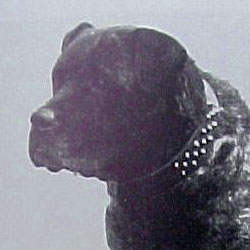Bullmastiff

 The legendary Bullmastiff was developed from the old English Mastiffs and original working bulldogges and bandogges with intentions of creating an ideal guard dog. Gamekeepers wanted a dog of imposing size and strength, but it also needed to be agile and quick, to help them patrol the large properties at night and chase down and apprehend intruders without needlessly mauling or killing them.
The legendary Bullmastiff was developed from the old English Mastiffs and original working bulldogges and bandogges with intentions of creating an ideal guard dog. Gamekeepers wanted a dog of imposing size and strength, but it also needed to be agile and quick, to help them patrol the large properties at night and chase down and apprehend intruders without needlessly mauling or killing them.
Even though bandogges of this type have been around for centuries, it is S.E.Moseley that reportedly came up with the perfect balance of 60 percent English Mastiff and 40 percent Bulldog, although it has been suggested that the French Dogue de Bordeaux also played a role in creating the Bullmastiff, as did the English Bullterrier, Alano Espanol, Bloodhound, Newfoundland, Saint Bernard, Labrador Retriever and the Deutsche Dogge, the recipe depending on regional preferences, working requirements and availability of the breeds mentioned. It should be noted that the "bulldog" part of the recipe was not the modern breed known as the English Bulldog, but the original variety of lean and athletic working dogs common in Britain at the time. Other programmes were present at the same time as the famed Moseley experiment, using different recipes and employing various guardian breeds, but these strains eventually died out, even though their influence on the Bullmastiff is sometimes suggested by a number of breed fanciers.

 Apart from the Moseley bloodline, another influential, as well as older strain of early Bullmastiffs was the celebrated Burton line, named after its developer, whose famous bandogge known as Thorneywood Terror gained notoriety for its superb working abilities and athleticism, eventually serving as the basis for the Bullmastiff breed Standard. Many Bullmastiffs were initially double-registered as English Mastiffs, but once the breed type was set, the two breeds were properly separated. Subsequent matings with the English Bulldog and the English Mastiff, as well as with other breeds, resulted in the establishment of the modern Bullmastiff, but many fanciers choose to believe that the breed remained unchanged throughout the years. Whatever the case may be, the English Bullmastiff was a major success. The breed was recognized in 1948 and remained a well-loved Show dog and family pet and protector worldwide ever since, although it differs from its original incarnation in both appearance and temperament.
Apart from the Moseley bloodline, another influential, as well as older strain of early Bullmastiffs was the celebrated Burton line, named after its developer, whose famous bandogge known as Thorneywood Terror gained notoriety for its superb working abilities and athleticism, eventually serving as the basis for the Bullmastiff breed Standard. Many Bullmastiffs were initially double-registered as English Mastiffs, but once the breed type was set, the two breeds were properly separated. Subsequent matings with the English Bulldog and the English Mastiff, as well as with other breeds, resulted in the establishment of the modern Bullmastiff, but many fanciers choose to believe that the breed remained unchanged throughout the years. Whatever the case may be, the English Bullmastiff was a major success. The breed was recognized in 1948 and remained a well-loved Show dog and family pet and protector worldwide ever since, although it differs from its original incarnation in both appearance and temperament.

 A very popular breed worldwide, the Bullmastiff makes a lovely companion and a good service dog, although true working lines are becoming rare. This is an even-tempered breed, loving of its owner and gentle with children. Proper training is essential, due to its great physical strength and somewhat confrontational nature. Muscular, wide-chested and agile, this is a very athletic Molosser. The head is large and round, reasonably wrinkled and having a shorter muzzle than associated with the breed's closest cousin, the English Mastiff. The muzzle itself is fairly blunt and square, with a black mask preferred and a black nose being a requirement.
A very popular breed worldwide, the Bullmastiff makes a lovely companion and a good service dog, although true working lines are becoming rare. This is an even-tempered breed, loving of its owner and gentle with children. Proper training is essential, due to its great physical strength and somewhat confrontational nature. Muscular, wide-chested and agile, this is a very athletic Molosser. The head is large and round, reasonably wrinkled and having a shorter muzzle than associated with the breed's closest cousin, the English Mastiff. The muzzle itself is fairly blunt and square, with a black mask preferred and a black nose being a requirement.
The flat coat is short, dense and weather resistant, most often coloured in solid fawn, red and brindle, with small white markings acceptable on the chest. Average height is around 26 inches.

-
If we stop owning
#caucasian#ovcharka this will probably be the next breed we keep.Good guardian and mot much barking



















